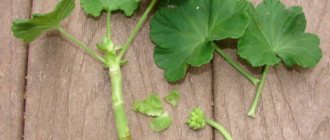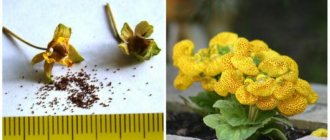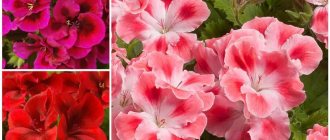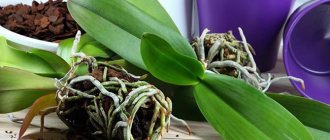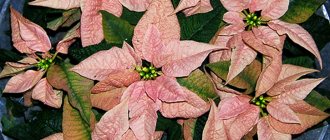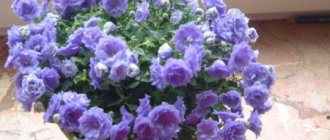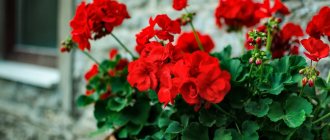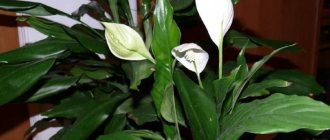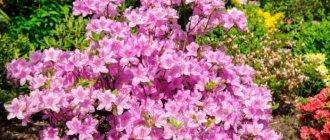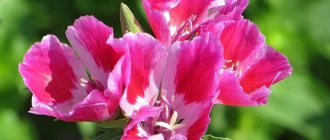Decorative use
Sometimes Viva Carolina is used in landscape design.
In this case, a low bush is placed in the foreground or middle ground. In home and artificial (insulated) flower beds, the plant looks great in hanging pots, in pots and flowerpots on the ground and on stands. Flowers look perfect on a windowsill or cabinet and do not need company due to their brightness and originality. However, the plant will play beautifully surrounded by crimson and lilac-blue inflorescences of other plants.
Lush Carolina pelargonium will delight you almost all year round
Anyone who wants to bring airy lightness and lush solemnity to their flower garden should have at least one of the beautiful Viva geraniums, and it will delight you with its charm every day.
Pelargonium PAC Salmon Komtess - what kind of hybrid variety is it
Flowers arrived from South Africa to European countries along with sailors in the 16th century. Breeders worked on improvements, as a result of which unpretentious varieties of the Geraniaceae family were obtained.
What pelargonium PAC Salmon Komtess looks like
Brief description and origin story
Pelargonium Pak Salmon Comtesse is a hybrid obtained in the German nursery PAC Elsner. He specializes in growing plants suitable for landscaping apartments, houses and streets. Their specimens are distinguished by increased resistance to adverse conditions and beauty.
The description contains the following information:
- average bush size - from 25 to 35 cm;
- the bushes are harmoniously folded, without excessive stretching;
- dark green foliage;
- Large double flowers with a soft pink color, they are collected in umbrella inflorescences located on vertical peduncles.
In the summer months, Salmon pelargonium grows calmly in open ground and is not afraid of cold temperatures down to −7 °C.
For your information! Frost-resistant varieties are more often used in landscape design.
Medicinal properties
Pelargonium Priory Salmon has the ability to improve the indoor microclimate. Due to the phytoncides included in the composition, the plant eliminates harmful bacteria, purifying the air.
Important! The main effect of the active components is considered to be the antiviral and antibacterial spectrum. They are able to cope with staphylococcal infections that cause serious illness.
Pelargonium Queen purifies the air in the room where it grows
Planting, propagation and further care
Viva Carolina pelargonium is planted in neutral soil; it is unpretentious to the composition of the soil; a standard garden mixture is suitable. It is recommended to fertilize with complex fertilizer 2 times a month.
The plant does not need frequent watering; it is enough to keep the earthen ball moist and not flood the roots. The ivy plant normally tolerates periodic spraying of the leaves to remove dust.
On a note! You should not keep the pot in the sun so that the inflorescences and leaves do not dry out and turn yellow ahead of time.
Pelargonium Carolina bushes well on its own, but to make the plant more fluffy and achieve a spherical bush, you can pinch and trim the shoots.
Pelargonium Viva Carolina is propagated by cuttings. First you need to root the material. At home, you can place the cuttings in a pot at the end of February. In open ground, this is done after the frosts have ended and the soil has completely warmed up.
Important! The plant does not like heat and drought. Plant or display the flower in partial shade, water moderately
In winter, watering is reduced, except in cases with artificial lighting.
How to properly care?
To care for the plant, the following factors must be taken into account:
- Temperature regime . The most common temperature is from 18 to 25 degrees. The flower does not like overheating and direct sunlight, which lead to burning of the leaves, their dryness and subsequent falling off.
- Watering . Water the plant only with settled or filtered water; preferably, the water should be at room temperature. The plant should be watered as the soil dries; do not overwater the flower, as this can lead to rotting of the root system. In summer, watering should be more abundant and regular; in winter it should be reduced, since the flower is dormant.
- Feeding . It is necessary to apply mineral fertilizers, which must be alternated with organic fertilizer. In summer, fertilizing should be done once every week and a half. In winter, fertilization should be reduced to once a month or once every six months.
- Humidity . Geranium loves fairly humid air, so you can place a container of water next to the plant and regularly spray the leaves and flowers.
Features of care
Let's get acquainted with the main points for caring for this beautiful pelargonium.
Watering
Millfield rose needs regular watering, but without waterlogging the soil. However, overdrying the earthen clod is also undesirable, since in this case the leaves of the plant fall off, which greatly reduces its decorative value.
Overmoistening is unacceptable, since the roots may rot due to waterlogging; in this case, it is usually impossible to save the plant. It is recommended to water the flower when the soil on top dries out, and in winter the frequency of watering must be significantly reduced.
Water for watering this pelargonium should be soft (settled) and at room temperature. Watering with cold water can cause the plant's roots to rot, so it's best to avoid this.
Note! The plant should not be sprayed, but it is necessary to wipe the dust from the leaves from time to time.
Use a slightly damp cloth for this procedure and immediately dry the flower well in sunlight.
Top dressing
In order for Millfield rose to bloom luxuriantly for a long time, the plant requires additional nutrition.
It is recommended to apply fertilizers carefully - it is better not to add any microelements than to overdo it in this case
In the spring, Millfield rose will gratefully respond to nitrogenous fertilizing, and thanks to it will form lush, bright foliage. Before flowering begins, it is necessary to stop using nitrogen and switch to fertilizing with potassium and phosphorus. This change in “diet” will allow the plant to form abundant inflorescences.
Use specialized complex mineral formulations sold in stores to feed pelargonium. The components in these complexes have already been optimally selected. Note that in winter, Millfield rose pelargonium does not need additional nutrition.
Trimming
In order for the bush to form dense and compact, Millfield rose pelargonium needs to be periodically pruned. The procedure promotes lush flowering of the plant, maintains its neat shape, and rejuvenates it.
It is necessary to monitor the elongated shoots throughout the growing season, and with the arrival of autumn it is recommended to carry out anti-aging pruning. The last procedure involves removing all old, dried and diseased branches.
Wintering
Pelargonium Millfield rose in winter must be given a period of rest, during which the flower should be watered extremely rarely and not fertilized.
The dormant period lasts from approximately November to February: as soon as daylight hours lengthen significantly, the plant will begin to wake up. In winter, it is necessary to keep pelargonium at a reduced air temperature (+12-15 degrees), since it is the moderate temperature that allows the plant to form many lush buds.
Note that in winter, the decorative value of Millfield rose pelargonium is greatly reduced, but you should not be afraid of this. A bare stem, a lack of flowers, a small amount of withered foliage: all this will become luxurious and lush again as soon as the growing season begins in the spring.
General information
This plant was first bred by breeders from Sweden, who soon after brought their brainchild to a European exhibition. There, pelargonium caused a great stir, which led to a flurry of positive reviews. This exquisite flower has become a multiple winner at various flower festivals, including in the capital of Russia, where it was brought in 2012.
The inflorescences of the PAC Viva variety have similar external features to rose buds and a flower such as ranunculus (a special type of buttercup). The surface of the petals resembles terry to the touch. The number of flowers on one umbrella can vary from 6 to 30 pieces. The size of an individual flower is about 5 centimeters. The arrangement of the buds in the inflorescence is quite free, which makes it easy to view each flower in the umbrella.
The growth of the inflorescence itself can occur over quite a long time. However, when the buds bloom, they will be able to delight you with their luxurious blooms for two weeks, and sometimes a little longer.
The plant itself is small, it is not a hanging plant, so it will not spread its branches to the sides. They grow quite close to each other. The leaves are hard in texture and rough to the touch. Their color is dark shades of green. Observing a plant that is in a well-lit room, it will become noticeable that its foliage is replenished with even more new leaves. Consequently, an increase in the number of leaves will be followed by an increase in the number of inflorescences. The flower will become even richer and more beautiful to look at.
Flower propagation by cuttings
You can propagate in two ways - cuttings or seeds. Propagation by seeds is very rarely used because the likelihood that the plant will retain its parental qualities is very low. Flower propagation by cuttings is most often used. The procedure is carried out as follows:
- Choose a strong flower.
- Cut off a healthy shoot with at least 2 internodes (more are allowed) and a length of at least 5 cm.
- The cuttings are left to dry for some time.
- Prepare the container and soil.
- Before planting, cuttings are treated with special means.
- The shoots are placed in prepared holes in containers with soil, watered, and the peat near the plant is compacted.
- Cups or pots are placed in a bright place, but so that they are not exposed to direct sunlight.
Within a month and a half, the cuttings will take root. It is better to carry out the procedure in spring or early summer. When propagating in winter, the sprouts should be provided with additional lighting. After the roots appear, you can transplant the flowers to a permanent place.
Pelargonium PAC Salmon Komtess (PAK Salmon Komtess)
Pelargonium PAC Salmon Komtess is a representative of a crop that can be grown indoors and outdoors. Bright flowers are widely used for decoration and landscape design.
Pelargonium PAC Salmon Komtess - what kind of hybrid variety is it
Flowers arrived from South Africa to European countries along with sailors in the 16th century. Breeders worked on improvements, as a result of which unpretentious varieties of the Geraniaceae family were obtained.
What pelargonium PAC Salmon Komtess looks like
Brief description and origin story
Pelargonium Pak Salmon Comtesse is a hybrid obtained in the German nursery PAC Elsner. He specializes in growing plants suitable for landscaping apartments, houses and streets. Their specimens are distinguished by increased resistance to adverse conditions and beauty.
The description contains the following information:
- average bush size - from 25 to 35 cm;
- the bushes are harmoniously folded, without excessive stretching;
- dark green foliage;
- Large double flowers with a soft pink color, they are collected in umbrella inflorescences located on vertical peduncles.
In the summer months, Salmon pelargonium grows calmly in open ground and is not afraid of cold temperatures down to −7 °C.
For your information! Frost-resistant varieties are more often used in landscape design.
Medicinal properties
Pelargonium Priory Salmon has the ability to improve the indoor microclimate. Due to the phytoncides included in the composition, the plant eliminates harmful bacteria, purifying the air.
Important! The main effect of the active components is considered to be the antiviral and antibacterial spectrum. They are able to cope with staphylococcal infections that cause serious illness.
Pelargonium Queen purifies the air in the room where it grows
Growing pelargonium PAK Salmon Comtess
The plant is unpretentious and does not require complex procedures. Violation of the rules of standard flower care can cause the development of diseases and pest attacks.
Illumination and temperature conditions
Pelargonium Salmon comtesse requires a sunny place, preference is given to the south and southeast direction. In all other cases, additional lighting is required.
In the summer months, the temperature in the room should not rise above 25 °C; in winter, it is better to keep it between 15 °C and 18 °C. You should also avoid drafts.
Important! Bushes must be shaded from direct sunlight to avoid burns on the foliage.
Watering rules and humidity
Zonal pelargonium does not like excess water and can easily tolerate drought. Flowers are watered as the earthen ball dries, but not more than twice a week. Soil moistening is carried out when the soil dries to one phalange of the finger.
Note! The humidity in the room should be standard. Additional spraying of the flower is necessary during extremely hot and dry summers.
Fertilizing and soil quality
Pelargonium Salmon Komtess prefers breathable, loose soil. The soil should be slightly acidic and moderately nutritious. Ready-made soil mixtures for Geraniums are purchased at flower shops and must contain:
- peat with sand and leaf soil;
- humus with agroperlite.
For feeding, use liquid solutions (1-2 times a month) or dry granular fertilizers with long-lasting action. In the latter case, regular enrichment of the soil with useful substances is carried out as they dissolve. Important elements for normal growth and development of flowers include magnesium with zinc, iron with iodine.
During the formation of buds, the plant is fed with potassium-phosphorus mixtures.
Important! Nitrogen fertilizers can be applied before flowers form. Later, their introduction will lead to a stop in development and the falling of the petals.
Flower container size
Requirements of pelargonium Comtess for pots:
- the size is at least 2 liters, otherwise the root system will be pressed against the walls, the buds on the plant will begin to dry out and the leaves will fall off;
- Containers must have drainage holes to prevent moisture stagnation.
Pruning and replanting
Pelargonium PAC Salmon requires pinching of young shoots. The procedure helps to give it the desired shape, to grow lush and beautiful. Replanting for young plants is necessary annually with a gradual increase in the size of the box; adult crops are transferred to other containers as the root system grows.
Features of plant flowering
The variety is characterized by long and abundant flowering. The flowers resemble tulips; from 8 to 10 buds are formed on low peduncles.
Period of activity and rest
Flowers decorate the apartment in the summer months; in winter it’s time to relax. If you want to extend the flowering time, it is enough to continue regular watering and fertilizing, and install additional lighting.
Types and shape of flowers
Variations of buds and their color depend on the variety:
- Queen - distinguished by large double flowers with a soft peach color;
- Night - with salmon flowers collected in large inflorescences;
- Princess - with double, notched buds, painted creamy white;
- Pop idol - bright salmon flowers, the plant is characterized by its minimal and compact size.
For your information! If you need to complement your interior with bright orange tones, you can pay attention to the Angeleyes Orange variety.
Flower propagation methods
Increasing the flower population is possible in two ways.
Cuttings
Suitable for hybrid species; after pruning the bushes, the most suitable shoots for planting are selected. The ends are cut at an angle of 45 °, wait until the cut area is covered with a film and becomes dull.
The cuttings are planted in small glasses, the soil is pre-moistened. They are sent to partial shade and wait for the first leaves to appear. Then the plant is transferred to a bright windowsill protected from direct sunlight.
Seeds
Non-hybrid types can be grown from seeds, as they retain the original characteristics of the mother bush. Seed material is soaked in water and sown in special soil at a distance of 3 to 5 cm from each other. The container is covered with film and sent to a dark room. The seedlings are ventilated and watered daily (when dry). After the formation of two leaves, the plants are transplanted into separate pots.
For your information! Geranium seeds are bought in flower shops, paying attention to expiration dates. The result depends on their freshness.
Growing problems, diseases and pests
Diseases dangerous to flowers include gray rot, stem rot, and root rot. Fungal infections occur due to violations of care rules: excessively moist soil and air, insufficient lighting and heat. The main enemies of the plant are insect pests: spider mites, aphids and whiteflies.
Description of the pelargonium variety PAC Viva Carolina and its characteristics
Viva Carolina belongs to the Geraniaceae family, as indicated by its ivy-like, succulent dark green leaves. It is a flower of medium height with creeping shoots that can spread up to 1.5 meters in length. On average, one bush gains up to 50-60 cm in height.
Luxurious terry inflorescences of Viva Carolina give a feeling of celebration
The flowers of the plant are rosebud, semi-double, thickening with age. Young buds are no different from pink ones, but every year they become fluffier, with a broken “skirt”. At first, 3-5 buds are formed on the peduncles, and after that their number can increase.
Additional Information. Pelargonium PAK Viva Carolina is distinguished by the unusual colors of its buds. At first they are soft pink, almost white, but after standing in the sun they become colored. Along the edges the “skirt” becomes lilac-pink, deeper the flower is white and has a greenish-yellow core.
Flowering lasts from late March to November. In good conditions under artificial light it can continue into winter. This type of geranium is quite hardy and tolerates cold temperatures down to +7 °C. It is recommended to keep the plant indoors, on a heated balcony, or in a greenhouse. In summer you can grow it outside.
Home care for Angel pelargonium: geranium flower varieties, propagation
Pelargonium Angel is a beautiful ornamental crop that has many advantages. This plant is characterized by lush flowering and is easy to care for.
Pelargonium Angel - what kind of flower is it
The genus Pelargonium belongs to the Geraniaceae family. This crop originally appeared in the tropical and subtropical climate of Africa.
This family, in addition to the royal geranium Angel, also includes other popular varieties - for example, Tip Top Duo. Representatives of the Pak variety series are especially popular today. These include varieties Bicolor and Viola.
Pelargonium is characterized by abundant and lush flowering
Brief description, history of origin or selection
If a flower lover grows Angels pelargonium, the varieties can be very different. All of them appeared by combining the royal and curly types. This happened at the beginning of the 20th century. The culture owes its appearance to the English breeder Arthur Langley-Smith.
Angelic culture is a plant 30-60 cm high. The bush is characterized by woody, not very wide stems with a large number of leaves. Some species are covered with small hairs with a fresh scent.
Important! The buds have an elongated shape with sharp ends. They resemble violets or pansies.
A distinctive feature of the culture is the difference between the color of the upper and lower petals. There are different color combinations - pink, scarlet, burgundy. White, lilac, purple tones are also possible. Often they are painted in 2 colors.
Varieties of indoor plants with names and what they look like
Pelargonium rosebud - how to care for geranium
Today there are many varieties of this pelargonium. Each of them has distinctive features.
Today there are many color variations of pelargoniums known
Angel Viola
This culture is a compact plant, which is characterized by long and lush flowering. All summer the bushes can be decorated with pink flowers. A characteristic feature is the contrasting crimson spot on the petals.
Angeleyes Orange
This plant has deep orange petals. The appearance of the bush is also improved by small leaves that have an openwork structure.
For reference! Pelargonium Orange is perfect for hanging structures.
Michael
This variety is characterized by small bushes and flowers with many petals. They have a cherry center and a white border.
Caring for pelargonium Angel at home
The variety is considered very unpretentious. At the same time, you need to care for it in compliance with certain rules.
Illumination and temperature conditions
Pelargonium Denise - a popular variety
Culture needs good lighting. In any case, the temperature in the house should not fall below +8 degrees. In spring and summer, the flower can be taken outside during the day. Temperature is especially important during the peak flowering period.
Important! For the winter, the flower pot should be taken to a cool room. This will improve bud formation next season.
Watering rules and humidity
Caring for Angel pelargonium at home includes timely moistening of the soil.
For irrigation, it is recommended to use exclusively warm and soft water. In this case, the soil should not be constantly wet. In summer, bushes need to be watered more abundantly, while in winter, watering can be reduced.
Fertilizing and soil quality
The culture requires special soil. If necessary, you can make the mixture yourself. To do this, you should mix turf, peat and a little sand.
Fertilizers should be applied at intervals of 2 weeks. This is done from spring to late autumn. In this case, it is necessary to use any combined compositions without excess nitrogen content.
The flower needs to be fed in time with special compounds
Flower container size
A medium container is suitable for the plant. The culture is growing rapidly. But if you plant it in a large pot, there is a risk of rapid development of branches and leaves. In this case, the bush will not be able to fully bloom.
Pruning and replanting
Pruning of the crop should be done 2 times a year. This is done in spring and autumn. Thanks to this procedure, you will be able to get a beautiful flower. Removing excess and dry shoots is of no small importance.
Important! The crop should be replanted quite rarely. The size of the pot should be chosen taking into account the root system.
Features of plant flowering
Pelargonium SOUTH Shukar, Aksinya, Ireland and other varieties
The culture is characterized by lush and abundant flowering. That is why it is so popular among flower growers.
- Period of activity and rest
Flowering begins in summer and continues until autumn. In winter, the flower experiences a dormant period. In spring, the bush forms new leaves.
During dormancy, you should not feed the flower or water it excessively.
The culture is characterized by small flowers. They resemble a viola in shape. Inflorescences can have different shades. There are also multi-color options.
Methods for propagating a flower, when is it best to do it
The plant can be propagated in different ways. Most often, propagation is carried out by cuttings or seeds. The florist decides which method to choose.
Propagation by cuttings
For cuttings, you need to cut shoots 10 cm in size. They should have 1-2 leaves. The branches should be placed in moist soil. It should consist of sand and peat.
After 2-4 weeks, the seedlings form roots. They need to be watered as the soil dries out.
The plant can be propagated by cuttings
Attention! It is not recommended to place plants in water. This method of rooting will lead to rotting of the root system.
Propagation by seeds
It is recommended to plant seeds from December to April. For this purpose, a composition based on sand and peat is used. The planting material should be buried 5 cm. The top of the container should be covered with glass or film.
The temperature should be +22..+24 degrees. After 4 leaves appear, the bushes can be replanted.
Growing problems, diseases and pests
The culture is considered very unpretentious. But sometimes she suffers from diseases and pests. Excess moisture leads to the development of gray rot. Pelargonium can also suffer from whitefly.
How to deal with them
To cope with diseases, fungicides are used. Insecticidal preparations are used to prevent insect attacks. Compliance with the rules of plant care is of no small importance.
Pelargonium (geranium) Angel is a popular crop that serves to decorate rooms. In order for a plant to develop well, it requires complete and high-quality care. It should include timely watering, fertilizing, and pruning. If everything is done correctly, angel flowers will delight you with colorful blooms.
Source: https://pocvetam.ru/komnatnye-rasteniya/tsvetushchie/pelargoniya-angel.html
Pelargonium Angel - what kind of flower is it
The culture belongs to the Geraniaceae family. The tropics and subtropics of Africa are considered its homeland.
Brief description and origin story
The plant appeared as a result of crossing curly and royal species back in the early 20th century. All varieties are characterized by unpretentiousness and fairly rapid growth. Plants love light and tolerate drought well.
For your information! Angel is often confused with royal geranium, but these are different plants.
Pelargonium is characterized by a large volume of foliage, sometimes it is terry. The bush is small in size and grows quickly. The shoots branch well, due to which the plant acquires splendor.
https://www.youtube.com/watch?v=gdbgjztVGpY
The flowering is abundant, the flowers look like pansies, and there are several inflorescences on one bush at once. The color of the petals is striking in variety: from pink to purple. Flowers can be white or combine several shades at once.
Note! As they grow, the shoots of pelargonium hang down, which allows them to be planted in hanging flowerpots and pots.
Pelargonium Angels: varieties for home breeding
Pelargonium Millfield Rose (Milfield Rose)
The new varieties are hybrids, so there are not too many of them. Breeders managed to obtain especially beautiful flowers.
What kind of home care is required for Pelargonium Angel?
Geranium Angel is an unpretentious plant. However, there are some features in care that should be taken into account.
Illumination and temperature conditions
Astilbe - what to plant next to
The flower loves light, but grows well in places where there is not sun all day. In a sunny place it grows quickly, the crown becomes denser.
The Angel variety does not tolerate temperatures below 8 °C. In spring and summer, the pots are taken out into the fresh air, but make sure that there is not a big difference between the degrees day and night. It is especially important to observe the temperature regime during flowering.
Note! The plant should overwinter in cool conditions so that the process of bud formation proceeds better.
Flowers resemble pansies
Watering rules and humidity
Pelargonium of this type does not like strong humidity. The plant should be watered with warm and soft water, but the soil should not be constantly wet. In summer, more abundant irrigation is carried out; in winter, watering is reduced.
Spraying is not important for pelargonium; it easily tolerates drought and room air.
Fertilizing and soil quality
For the plant, it is better to choose a special soil for pelargoniums or geraniums. If necessary, you can mix the soil mixture yourself by taking peat, turf and a small amount of sand.
Important! Before planting, the soil is calcined in the oven to destroy harmful insects and parasites.
You need to feed the flower every 2 weeks from spring to late autumn. It is possible to use any complex fertilizers, but you should make sure that there is no excess nitrogen. Otherwise, the plant will have more foliage than flowers. During the formation of buds, fertilizing is carried out with phosphorus and potassium fertilizers.
Pruning and replanting
The plant needs to be trimmed a couple of times a year - in spring and autumn, sometimes in summer. This will help form a beautiful flower and encourage abundant flowering. Be sure to remove dried and excess shoots.
Transplantation is carried out quite rarely. The pot is selected depending on the root system. Drainage is placed at the bottom.
Period of activity and rest
Flowering occurs in summer until autumn. In winter, the flower has a dormant period; in spring, fresh foliage gradually appears.
Types and shape of flowers
The flowers are small in size, they are very similar to viola flowers. The colors are varied, the upper and lower petals can have different colors, even bicolor and tricolor are possible.
Flower propagation methods
You can propagate Angel pelargonium at home in two ways - cuttings and seeds.
Growing problems, diseases and pests
Pelargonium of the angelic variety is an unpretentious plant, but can be susceptible to diseases and pests.
If there is excess moisture, the flower can be destroyed by gray rot. Fungal diseases cannot be ruled out. Pelargonium is often attacked by whitefly, which infects the leaves.
Gray rot on leaves
The fight against diseases and pests consists of preventive treatment of the plant with special means. Fungicidal and antibacterial drugs are suitable. With proper care, most problems can be avoided.
Pelargonium Angel is a very beautiful plant that will delight its appearance during the flowering period. You need to follow simple rules of care in order to get strong and durable flowers that will decorate your garden and premises.
Source: https://greensotka.ru/tsvetushchie/pelargoniya-angel.html
How to reproduce?
This variety of pelargonium, being picky in care and maintenance, shows a little of its “character” when propagated. However, following planting and germination technology will help you grow a healthy and strong plant.
Note that rosebud pelargoniums reproduce at home exclusively by cuttings, since when propagated by seed, these hybrids do not inherit maternal qualities. That is, from seeds you will get ordinary pelargonium, but not rosebud.
In this case, cuttings can be carried out year-round. But experienced flower growers advise propagating Anita from March to July. Below is a detailed algorithm for the propagation procedure of this plant.
The first step is to separate a suitable apical cutting from five to seven centimeters long from the mother plant. It is important that the cutting is semi-lignified, since soft green young shoots will not take root. It is necessary to cut off the process with a sharp knife with a sterile blade.
Use purchased soil for planting, since self-prepared soil will require thorough disinfection. And this procedure at home is quite difficult to carry out correctly.
The cut cuttings are dried and planted in a plastic cup, where holes must first be made for drainage, filled with an earthen mixture. Before planting, it is important to cut off all the leaves from the bottom of the petiole (which will be underground) so that they do not rot underground.
Within two to three weeks the cutting will take root.
Water it carefully immediately after planting, avoiding flooding, but also not overdrying. Water should be strictly at the root, or better yet, pour water along the edge of the glass
Use water sparingly so that the cuttings do not begin to rot before rooting.
For successful rooting, it is important that the cuttings are well lit. If this happens during short daylight hours, provide the plant with additional artificial lighting.
Reproduction
Pelargonium Pak is propagated at home by cuttings. This option is simpler, and its result is much more predictable: the plant simply turns out exactly the same as the mother one. In the case of seed propagation, the result is sometimes not what was expected, since the resulting plant often does not inherit the parental qualities. Let's take a closer look at propagation using cuttings.
The algorithm is as follows:
The apical shoot up to 7 cm long is cut from the mother plant;- The shoot is dried for eight to ten hours, wrapped in paper;
- after drying, the cuttings are rooted in a glass with prepared soil;
It is possible to first grow roots in water, however, this method does not affect the final result. In addition, the stem of a plant often rots in water, so using the water method is still undesirable. After 10-20 days, the shoot takes root in the soil. To make rooting faster, place the glass with the plant on a well-lit windowsill and water regularly.
If you are interested in learning about other varieties of pelargonium, you can read about, PAK Salmon, April Snow, Angel, Prince Gustav, Rose Zonartik, Richard Hudson, Zvezdchataya, Denise, Norland.
Pelargonium PAK Viva - what kind of flowers are they?
Pelargonium Pak Viva is very often found in houses and apartments. Plants of this variety do not require special care, and during the flowering period they decorate rooms very decoratively with their appearance.
Pelargonium PAK Viva
For the first time PAK Viva was received in Sweden. After some time, breeders presented it at a European exhibition, where the plant received a lot of positive feedback. In 2012, a similar pelargonium appeared in Russia and also quickly gained popularity.
The bush has a compact size. The flower is not ampelous; all branches are located close to each other. The leaves are green and quite dense to the touch. In a room with good lighting it grows quite quickly.
For reference! The inflorescences of all PAC Viva are similar to rose buds and flowers of a plant such as ranunculus (buttercup).
Terry petals on the surface. The number of flowers in one inflorescence can reach up to 30 pieces. The process of bud formation lasts quite a long time. However, once they bloom, the blooms can last for about a couple of weeks. In some cases a little longer.
Diseases and pests
After summer has arrived and the plant has moved to the open air, its health becomes susceptible to attacks by various pests and diseases. What to do and how to avoid such problems?
First you need to understand what caused the “blow” to the plant. Most often, infection of a flower manifests itself in lethargy and dullness of the leaves, brown and yellow spots, and dryness. With such symptoms, you should think about the health of the plant and be wary.
The most common diseases of ivy pelargonium are:
- Botrytis fungus.
This is usually caused by excessive humidity. The fungus appears as brown spots and the formation of gray fluff on the leaves. Rapid spread leads to leaf fall. With such a fungus, you should cut off all infected areas and transplant the flower into another pot, spraying it with fungicides. - Root system rot.
Rot is also caused by excess moisture. Subsequently, the rot spreads throughout the stem from bottom to top. This infection is characterized by brown and black colors. To avoid further spread of rot, the soil should be replaced with a looser one so that water cannot stagnate in it. - Bacterial diseases.
This type of disease does not lead to the death of the crop, but it does cause a serious blow. The stem partially darkens and withers. Treatment consists of frequent spraying and weeding. - Ticks.
Appear as yellow specks on the leaves and stem. The reasons for such a visit may be dry air and high temperatures. Such lesions are treated with soap and mineral oil. If the process is too advanced, then chemicals such as Ditox, Molniya and others can come to the rescue. - Aphid.
Aphids can be identified by special signs: the leaves of the flower begin to curl. Such sheets must be cut off and the rest washed with soapy water. Also, the preparations “Tobacco dust”, “Iskra” and others save from aphids. - Thrips.
It appears in the form of growths on the back side of the leaf. Leads to deformation of leaves and the appearance of yellow spots. The drugs “Biotlik”, “Aktara”, etc. help prevent the appearance of thrips.
Growing problems, diseases and pests
Diseases dangerous to flowers include gray rot, stem rot, and root rot. Fungal infections occur due to violations of care rules: excessively moist soil and air, insufficient lighting and heat. The main enemies of the plant are insect pests: spider mites, aphids and whiteflies.
Gray rot
Note! Most parasitic organisms enter the house along with soil taken from the forest or garden plot. Flower growers advise using ready-made soil mixtures or disinfecting soil prepared independently.
How to deal with them
All types of fungus, except root rot, are treated with fungicides. Success depends on identifying the problem early and taking action. Therapy for bushes affected by parasites comes down to manually treating the leaves with a cotton pad dipped in a soap solution. After cleaning the green part from pests, you can carry out additional treatment with insecticides.
Pelargonium will decorate any windowsill
The Geraniev family is distinguished by its unusually beautiful flowers and unpretentiousness. Compliance with the rules of watering and fertilizing, timely replanting will help you grow an ideal mini-garden in your apartment.
Home care
- To ensure that ivy pelargonium does not lose its flowers and has a lush crown, it must be pruned every year. During pruning, its shoots are either completely removed or shortened to 2-3 nodes. In addition to pruning, the plant also regularly requires removal of dry leaves and stems.
Dry leaves and stems should not be plucked; scissors must be used to do this to avoid rotting and infection of the flower.If possible, cut areas can be treated with crushed activated carbon.
- The optimal temperature for flowering ivy-shaped pelargonium is 20-25 degrees, but the plant feels great even on hotter days, does not wither and continues to bloom.
- In summer, it is best to keep such a flower outside, placing it in the open air and allowing it to enjoy the rays of the sun. You should not immediately place the flower under the scorching sun; first you need to let it acclimatize.
Landing
Let's find out what the requirements of Pak pelargonium are for its habitat: what kind of lighting this plant needs, soil composition, temperature and other points.
Location and lighting
Pelargonium Pak needs a fairly plentiful amount of light. But since these plants are intended for landscape gardening, there should be no problems with lighting. However, plants are also grown at home - in this case it is recommended to place the flower pot on a south or south-east window sill: here the pelargonium will be provided with the amount of sunlight it needs.
If the apartment is dark and the windows face north, it is recommended to organize additional artificial lighting for Pelargonium Pak. With a lack of light, the plant loses its decorative effect, refuses to bloom, and withers. But it is better to shade the plant from direct sunlight, as burns on the leaves are likely.
Temperature
Pelargonium Pak feels best in moderate temperature conditions. In summer, the plant will develop and bloom safely at a temperature of +17-23 degrees, but in winter a cooler temperature of +13-15 degrees is required. In winter, if the plant is outdoors in summer, it must be brought indoors and planted back outdoors only when the threat of night frosts has completely passed.
Note that too low temperatures negatively affect the flowering of pelargonium, so allowing the plant to remain in the cold is extremely undesirable.
Soil composition
Pelargonium Pak will grow well in loose soil. You can buy ready-made soil for geraniums in the store, or prepare it yourself. In the latter case, the composition required is as follows:
- leaf soil - 3 parts;
- coarse river sand - 1 part;
- charcoal - 1 part;
- peat substrate - 1 part.
Appearance
Since Millfield rose contains the properties of both ivy-leaved and zonal pelargonium, this fact was also reflected in the appearance of the plant. Thus, the shape of the leaves and their color indicate that the variety belongs to zonal species, and the growth pattern and shape of the shoots indicate the ivy-leaved “ancestors” of the plant.
The inflorescences are quite large and voluminous, which gives the plant splendor and decorativeness. Due to the heaviness of the inflorescences, the plant requires gartering, as well as timely pruning - otherwise Millfield Rose will turn into a hanging plant, and its flowering will become less lush and abundant.
The leaves are large, bright, and also beautiful and decorative in their own way. In bright light, a characteristic brown stripe on the leaves becomes noticeable, indicating that the plant belongs to zonal varieties.
Appearance
Pak varieties have unique decorative qualities. The bushes of the plant are formed quite compact, stocky, strewn with lush inflorescences of large buds. One inflorescence usually contains about 10-15 flowers, and there may be several such inflorescences on a bush. Almost all Pak varieties have double flowers, which makes the plants even more visually impressive.
Externally, the Pak pelargonium bush resembles a bush rose of ancient tea varieties , which flower growers and landscape designers really like. The compact plant turns out to be quite powerful, but due to its spectacular flowers it looks elegant. In addition, Pak pelargoniums also have beautiful foliage: serrated, rich dark green. Flowers look very elegant against the background of decorative leaves.
